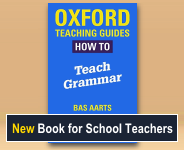Phrases
A phrase consists of one or more words that belong together. It takes one of the major word class elements (noun, adjective, etc.) as its Head.
Our definition is slightly different from the one given in the National Curriculum which stipulates that phrases must contain at least two words, though it concedes that "some grammarians recognise one-word phrases". Under this view, a noun or pronoun (or other Head) occurring on its own is just a noun, even though it occurs in a noun phrase position. The reason for doing things this way is purely pedagocial: it's easier for pupils to understand.
The Head is the most central word in any phrase. Phrases can also include other elements which in some way modify the Head.
Take the example blue balloons. Here blue balloons is a phrase: the two words belong together, with balloons as the Head and blue modifying its meaning. Because the central word here is a noun, we call this a noun phrase.
The modifying elements (called modifiers) can also come after the Head, as in balloons in the sky.
There are five main types of phrase:
- noun phrase (NP)
- verb phrase (VP)
- adjective phrase (AJP)
- preposition phrase (PP)
- adverb phrase (AVP)
A noun phrase has a noun or pronoun as its Head, a verb phrase a verb, an adjective phrase an adjective, and so on.
In each of the following examples we have marked out the NP with square brackets and highlighted the Head noun.
- Well you married [a strong woman] too. [S1B-041 #173]
- The country created [such a strong impression] on us! [W1B-013 #100]
- And you’ve got to recognise [the things that are regular]. [S1B-012 #71]
Similarly, in each of these examples the VP has square brackets and the Head verb is highlighted.
- However, I [will speak] to you shortly. [S1A-095 #159]
- She [might have been] that kind of teenager anyway. [S1A-031 #94]
- And they [are bringing] the ball forward. [S2A-018 #241]
Please note that the National Curriculum does not discuss verb phrases. In the NC, clauses are defined as 'a special type of phrase whose Head is a verb'.
Adjective phrases have an adjective as Head, and often also include modifiers before the Head, such as too, quite, very and a lot more.
- I mean I'm [too lazy] really for that I think. [S1A-002 #12]
- But it was only for an hour or two so I didn’t feel [quite so bad]. [S1A-076 #109]
- He 's got [a lot more thoughtful]. [S1A-076 #49]
Here are some preposition phrases:
- There’s the vicar [under the car]. [S1A-063 # 207]
- ... a very reasonable bid [to the European community]. [S1B-056 #72]
- The lack [of such an awareness] ... [W2A-011 #67]
And finally here are some examples of adverb phrases.
- As a local resident I wish to protest [most strongly] that such a development would change the whole character of the village. [W1B-025 #102]
- I am going to try to raise enough money to come over for a weekend [very soon].[W1B-008 #136]
- She remembered [quite clearly] that she’d once or twice slapped Anne-Marie [too hard] for a minor offence. [W2F-020 #55]
So far we have looked at examples where several words group together to form a phrase. However, we can also have very simple phrases which consist only of a Head word. Let’s look at some examples to see how this works.
If we remove the modifiers from the noun phrase in (1) below, we are left with just a Head noun, as in (2):
- [Most children under five] are very active.
- [Children] are very active.
Children here is a very simple noun phrase. It contains just a noun as its Head. But it functions just like the longer noun phrase in (1) to identify who is described as being very active.
As noted above the National Curriculum stipulates that phrases must contain at least two words, so that in the second sentence above children is just a noun.
Here are some more examples of noun phrases of different lengths:
- [I] made a note at the time and afterwards. [S1B-068 #11]
- I don’t know [the name of the road]. [S1A-014 #226]
- [The opening of the regular sea routes between the Mediterranean and the Channel at the end of the thirteenth century] tied Portugal, Spain and England. [S2B-043 #14]
One way of checking to see if a group of words is a noun phrase is by a substitution test. Can we substitute a pronoun for the group of words?
In the case of the first example, the Head word is already a pronoun so this test won’t work. But in the case of (2) and (3), the pronoun it could take the place of the whole phrase:
- I don't know it
- It tied Portugal, Spain and England
So these are noun phrases.
Within both (2) and (3) you can also see other phrases. Within the noun phrase the name of the road, we can also pick out the following:
- the name (noun phrase)
- the road (noun phrase)
- of the road (preposition phrase)
In this last case, the preposition phrase has the preposition of as its Head word.
Phrases can exist within phrases, as you can see from this example. Some phrases can even contain clauses. An example is the noun phrase things that go bump in the night. Here the string that go bump in the night is a relative clause.
Welcome!

Englicious is totally free for everyone to use!
But in exchange, we ask that you register for an account on our site.
If you’ve already registered, you can log in straight away.
Since this is your first visit today, you can see this page by clicking the button below.
- Printer-friendly version
- Log in to view or leave comments

